Once a residential area for well heeled Washingtonians, the Penn Quarter has a mixed history. Chinese immigrants arrived around 1930 and set up a small Chinatown district. By the 1950s, residents started to move out to the suburbs and over the next 30 years the area went steadily down hill. The decline was reversed in 1997 when the Verizon Center opened, a sports stadium and entertainment complex that attracted many new restaurants and shops to open within and around the Center.
Donald W Reynolds Center for American Art
The classical facade of this building shouts ‘art gallery’ at you, so it may be a surprise to hear that this building completed in 1867 was originally the U.S. Patent Office. In 1932 it became home to the Civil Service Commission then in the 1950s it was threatened with demolition. It was saved by President Dwight D. Eisenhower who in 1958 signed legislation giving it to the Smithsonian Institution. In January 1968 the building reopened as the Donald W Reynolds Center for American Art, housing the National Museum of American Art (now the Smithsonian American Art Museum) and the National Portrait Gallery.
Friendship Arch, Chinatown, H Street
Just our luck that the Friendship Arch was undergoing major renovations during our 2009 visit to D.C. as the gate is the most impressive aspect of Chinatown. In New York, San Francisco and London when you enter Chinatown you feel that you have been instantly transported to China. The D.C. Chinatown is small and far from exclusively Chinese and hence lacks that ‘feel’. Click Tab 2 to see a typical Chinatown street scene.
Penn Quarter & Chinatown
Click on Minimap to navigate
Home > US States > Midatlantic USA > Washington DC >
Presidents Box, Fords Theatre
Although Fords Theatre still functions as a theatre, it is a tragic incident in history that brings most people here. On April 14 1865, with the Civil War newly won for the Union side, Abraham Lincoln attended a performance here. John Wilkes Booth, an actor and supporter of the Confederacy, entered the Presidents Box and shot Lincoln. Despite injuring his leg, Booth escaped, but was shot and killed in Virginia some weeks later. Lincoln was taken across the road to Petersen's Boarding House. He died the next morning without regaining consciousness, the first US President to be assassinated. The theatre is now a National Historic Site. Click Tab 2 to see the Petersen Boarding House.
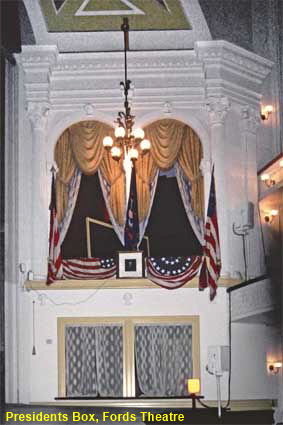
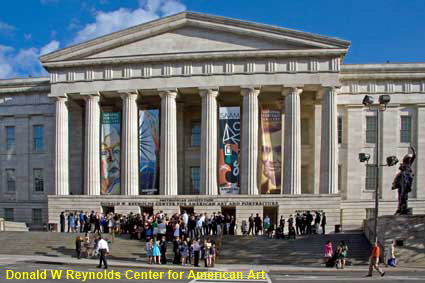
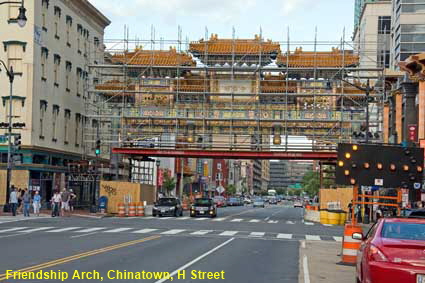
Old buildings in 7th Street NW
When the Penn Quarter was in decline, many buildings were derelict and boarded up. The shops that remained were mainly downmarket discount shops. Fortunately the revitalisation of the Penn Quarter did not result in wholesale demolition of the old buildings. In 7th Street NW some of the old buildings are now smart shops and restaurants.
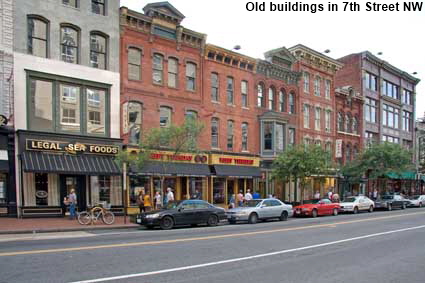
DLU100618
Calvary Baptist Church, H and 8th Streets
Tall, slender and very red, the Calvary Baptist Church can hardly be missed as you walk along H Street. Founded in 1862 by a group of prominent Baptists who took the Union side during the Civil War, the church was designed by German-born architect Adolf Cluss and completed in 1866. The steeple was severely weakened by a 1914 storm and had to be pulled down. For more than 90 years the church had no steeple, just a short tower that was lower than the apex of the roof. In 2005 a new steeple was fitted to restore the church to its former glory.
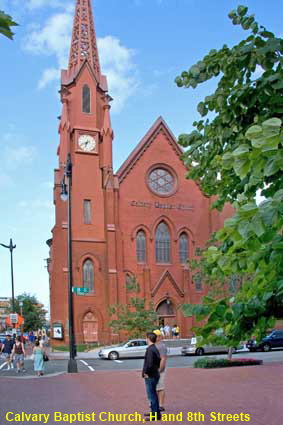


To move forwards or backwards through the Washington DC trail click the arrows above, or select your next destination on the Minimap.
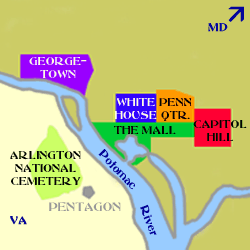

© Mike Elsden 1981 - 2025
The contents of this page may not be reproduced in full or in part without permission